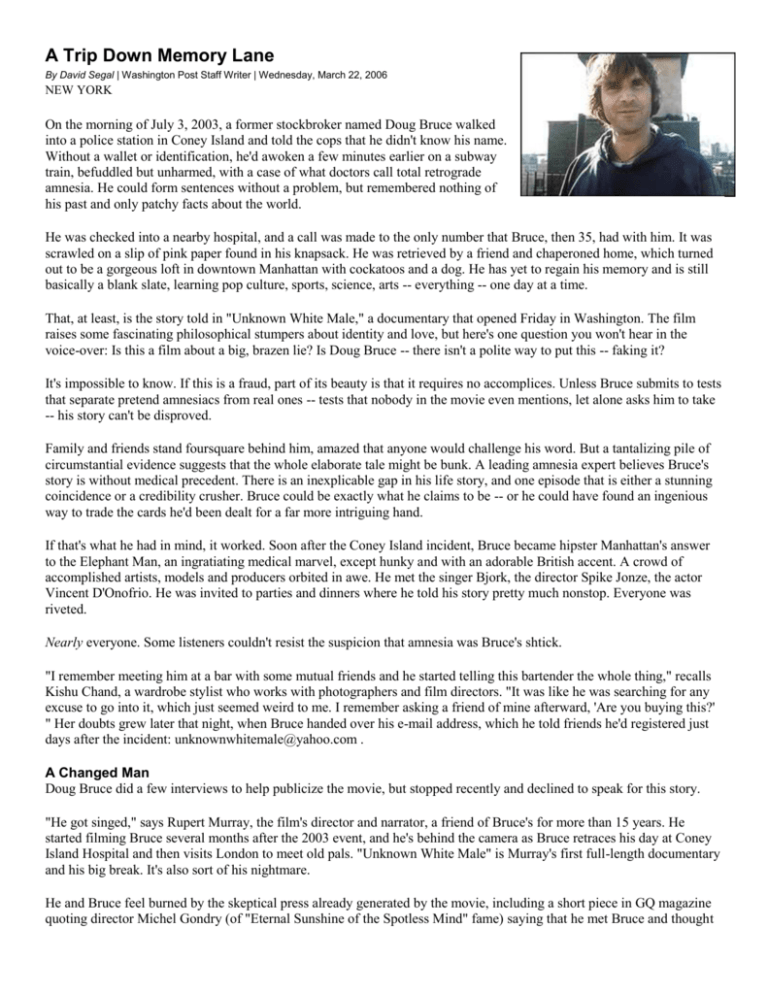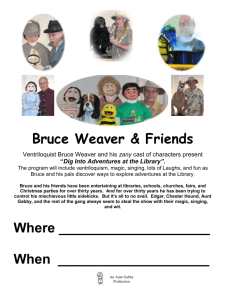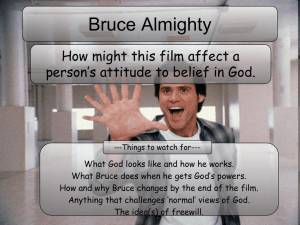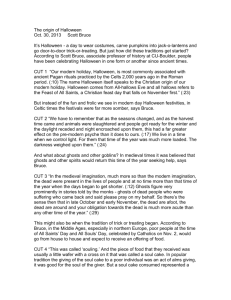A Trip Down Memory Lane - Bremerton School District
advertisement

A Trip Down Memory Lane By David Segal | Washington Post Staff Writer | Wednesday, March 22, 2006 NEW YORK On the morning of July 3, 2003, a former stockbroker named Doug Bruce walked into a police station in Coney Island and told the cops that he didn't know his name. Without a wallet or identification, he'd awoken a few minutes earlier on a subway train, befuddled but unharmed, with a case of what doctors call total retrograde amnesia. He could form sentences without a problem, but remembered nothing of his past and only patchy facts about the world. He was checked into a nearby hospital, and a call was made to the only number that Bruce, then 35, had with him. It was scrawled on a slip of pink paper found in his knapsack. He was retrieved by a friend and chaperoned home, which turned out to be a gorgeous loft in downtown Manhattan with cockatoos and a dog. He has yet to regain his memory and is still basically a blank slate, learning pop culture, sports, science, arts -- everything -- one day at a time. That, at least, is the story told in "Unknown White Male," a documentary that opened Friday in Washington. The film raises some fascinating philosophical stumpers about identity and love, but here's one question you won't hear in the voice-over: Is this a film about a big, brazen lie? Is Doug Bruce -- there isn't a polite way to put this -- faking it? It's impossible to know. If this is a fraud, part of its beauty is that it requires no accomplices. Unless Bruce submits to tests that separate pretend amnesiacs from real ones -- tests that nobody in the movie even mentions, let alone asks him to take -- his story can't be disproved. Family and friends stand foursquare behind him, amazed that anyone would challenge his word. But a tantalizing pile of circumstantial evidence suggests that the whole elaborate tale might be bunk. A leading amnesia expert believes Bruce's story is without medical precedent. There is an inexplicable gap in his life story, and one episode that is either a stunning coincidence or a credibility crusher. Bruce could be exactly what he claims to be -- or he could have found an ingenious way to trade the cards he'd been dealt for a far more intriguing hand. If that's what he had in mind, it worked. Soon after the Coney Island incident, Bruce became hipster Manhattan's answer to the Elephant Man, an ingratiating medical marvel, except hunky and with an adorable British accent. A crowd of accomplished artists, models and producers orbited in awe. He met the singer Bjork, the director Spike Jonze, the actor Vincent D'Onofrio. He was invited to parties and dinners where he told his story pretty much nonstop. Everyone was riveted. Nearly everyone. Some listeners couldn't resist the suspicion that amnesia was Bruce's shtick. "I remember meeting him at a bar with some mutual friends and he started telling this bartender the whole thing," recalls Kishu Chand, a wardrobe stylist who works with photographers and film directors. "It was like he was searching for any excuse to go into it, which just seemed weird to me. I remember asking a friend of mine afterward, 'Are you buying this?' " Her doubts grew later that night, when Bruce handed over his e-mail address, which he told friends he'd registered just days after the incident: unknownwhitemale@yahoo.com . A Changed Man Doug Bruce did a few interviews to help publicize the movie, but stopped recently and declined to speak for this story. "He got singed," says Rupert Murray, the film's director and narrator, a friend of Bruce's for more than 15 years. He started filming Bruce several months after the 2003 event, and he's behind the camera as Bruce retraces his day at Coney Island Hospital and then visits London to meet old pals. "Unknown White Male" is Murray's first full-length documentary and his big break. It's also sort of his nightmare. He and Bruce feel burned by the skeptical press already generated by the movie, including a short piece in GQ magazine quoting director Michel Gondry (of "Eternal Sunshine of the Spotless Mind" fame) saying that he met Bruce and thought him a phony. Murray is sitting in a conference room in the Manhattan offices of Wellspring, the movie's distributor. He doesn't seem to be having any fun. "I was telling his story," he says at one point. "Not your story, not the story of a journalist. The story of a friend, and I don't have to [freaking] prove anything to anyone." Murray would walk out of this interview in a low-boil rage about 20 minutes later, with the cinematic exit line, "I am not a [freaking] sociopath." (He was dismissing the possibility that he and Bruce cooked up the whole thing together.) When he calls to apologize the next day, he says he's simply tired of questions about the truth of "Unknown White Male." So, it seems, are Bruce's many supporters. "I really want to be explicit," says Stephen Frailey, who heads the photography department at the School of Visual Arts, where Bruce was enrolled before and after the alleged incident. "I believe completely in this event. I watched people go up to Doug after it happened and say hello, people he knew, and he just looked blank. You could see it in his eyes. He was completely lost." In the movie and in phone interviews, friends and family say that the pre-amnesia Bruce was a slightly arrogant, hardedged cynic, and had been his whole life. Raised in Nigeria, where his father managed a series of businesses, and educated at a boarding school in England, he'd dropped out of college in his twenties and apparently earned millions in Paris courtesy of the stock market. In 1999, he retired from the business world, moved to Manhattan and enrolled in a four-year course in photography. "He seemed like this typical kind of total Eurotrash banker dude," says Nadine Adamson, the woman who claimed Bruce at Coney Island Hospital. "He was chasing models, had this big loft, 'let's go to Biarritz.' For a few seconds, it was appealing." The pair had gone out a few times before the alleged incident, while she was living at her mom's place. (The number in Bruce's knapsack was for Adamson's mother.) Uninterested, Adamson stopped returning Bruce's calls. But once beckoned to the hospital that day in July, she helped ease Bruce back into the world. Adamson's pals thought she was getting hoodwinked by a guy who wanted a second shot at bedding her, but she says they kept it platonic. "He didn't know his way around his own apartment," says Adamson, who now lives in London and remains a firm believer in Bruce. "It was like dealing with a child. He lost a lot of his cockiness. He became nicer." This is a refrain you hear often: Bruce's story must be real because he is transformed. Word spread about this beatific man-child who was discovering chocolate mousse, rock-and-roll, cinema and history all over again. He claimed to have lost episodic memory (the story of his life), as well as much of his semantic memory (knowledge of the world), while retaining most procedural memory (the ability to swim, for instance). Bruce could use chopsticks, but he couldn't remember eating sushi, and said he had a weird jumble of facts at his disposal. He knew the names of some cities in Australia, for instance, but nothing about the attacks of 9/11. Adamson introduced him to a friend named Richard Brown, a British film producer who lives in Manhattan, and the two became friends. Within days, Brown was interviewing Bruce on video; about eight minutes of that footage appears in the movie. He introduced his subject to a rarefied stratum of pals and acquaintances in the film and music industries. Even among celebrities, at any dinner or gathering where the story came up, Bruce took center stage. And the story, it seems, always came up. Bruce would inevitably stammer something like, "I'm sorry, who is Bono?" and, bingo, he was off and running. It wasn't just a fantastic tale. As a man apparently reborn to his senses, Bruce would profess amazement at the mundane in ways that humbled and touched his listeners. He had an almost mystical charisma. “He would listen intently to every syllable you said, even if you were just describing how to cook an egg," says Chris Doyle, the acclaimed cinematographer of films such as "Hero" and "Rabbit-Proof Fence," who dined with Bruce on five or six occasions. "Most of us, we want that sort of wonder in our lives and we rarely experience it." But eventually, there were doubters. "At first, Doug was very believable and fascinating to be around, but at the same time, there were apparent inconsistencies," says Brown, who quit videotaping Bruce. "On one hand, he had to ask who George Bush was, but on the other, he could hold nuanced conversations about Middle Eastern politics. He would always preface such conversations with the disclaimer, 'I don't know but I've been told,' yet he had an incredible command of the facts and an extremely perceptive insight, and after a few weeks I started to have doubts about the veracity of his story." Others realized that Bruce seemed to relish his condition. Some friends swear he was hesitant to share his extraordinary tale, but when he posted a profile of himself on Friendster, a Web site dedicated to social networking, it sure sounded like he was working it. His page is still up, complete with photos of himself and his cockatoos. In the "About Me" section, he's written, "mmmm . . . i have the perceptiveness of a 35 yrd old with the naievety and vulnerability of a 3 month old infant. (but am growing up fast!!!)" Under "Who I want to meet," he wrote, "the person who banged me on the head and stole my memory." Under occupation, he wrote "fugal amnesiac." No Explanation Amnesia -- fugal and otherwise -- is rampant in soap operas but rare in the real world. Most cases involve accidents followed by a few seconds or minutes of memory loss. Total retrograde amnesia is quite rare, and the number of cases that last more than a few days is tiny. Hans Markowitsch, a neural psychologist and professor at the University of Bielefeld in Germany, has studied dozens of examples of total retrograde amnesia. Every one that he's encountered or read about can be traced to severe mental or physical trauma. "Even when the patient has no idea what that trauma is, if you dig around long enough, you find it," says Markowitsch on the phone. In "Unknown White Male," a Harvard psychology professor gives a primer on amnesia, but the only physiological explanation floated for Bruce's memory loss is an MRI that shows a small congenital tumor on his pituitary gland. There were also three small bumps on his head the day he walked into the police station. The only psychotraumatic explanation hinted at is the death of Bruce's mother, though that happened years ago. It's possible that some combination of these factors accounts for his amnesia, but the doctors in the movie doubt it, and even Murray concludes before the credits roll that no amount of testing or consultations can solve the mystery of Bruce's condition. Which technically isn't true. With a functional MRI, or fMRI, the truth of an amnesiac's claims can be put to a test. When confronted with questions about their past, there is a distinct pattern in the right frontal part of the brain in subjects who remember personal events, which an fMRI will pick up. Given that medical science was stumped, why not test for fakery? "Then he wouldn't have made the film," snaps Murray, a little indignantly. "How would you explain to your friend, he's just about to make a documentary, 'Before we start [would you take an fMRI?]' It's just rude." To Markowitsch, the absence of any plausible trigger makes Bruce's story more than just suspicious. "Total retrograde amnesia doesn't happen out of nothing," he says. "I can't imagine that this story is true." What the Film Left Out If Bruce did invent this whole episode, where did he get the idea? Take your pick of movies -- anything from "Regarding Henry" to "50 First Dates." But it's also possible he lifted the concept from a friend. In a coincidence that defies Lotto-size odds, Bruce knew a man in Paris who suffered a weeklong bout of severe amnesia and used the ordeal to rethink his life. According to a former girlfriend, who remains close to Bruce and is convinced he is telling the truth, a friend had an onfield collision during a pickup soccer game, landing him in the hospital without any identification and no memory of his life. His family thought he was dead, until they scoured area hospitals and found him. It's not in the movie, but Bruce mentions this episode during the videotaped interviews shot a few days after the alleged onset of amnesia. In a copy obtained by The Washington Post, Bruce says the friend set aside his hard-charging business career and moved to either Bali or Thailand, where he learned to give massages. "And now he heals people," Bruce whispers. During those same interviews, Bruce also seems to commit a rare gaffe. He says it was raining the morning he walked into the Coney Island police department. A couple days later, while sitting in his apartment and being interviewed, he says that he'd taken a walk a day earlier and seen a breathtaking summer storm. "It was the first time," he mutters, choking up, "that I had ever seen rain." A more curious filmmaker would surely have quizzed Bruce about this contradiction, and perhaps asked a follow-up or two about that soccer accident. There are also mysteries the film doesn't touch, including a weird blank patch during the years that Bruce made his fortune in Paris. Everyone contacted for this story said either that they didn't know how he made that money or wouldn't say. Why this is a mystery is itself a mystery, but it is a conspicuous obstacle to sifting through Bruce's past, and it produced this head-scratcher of an answer from Murray. "Somebody told [Bruce] the name of the firm, but he forgot it. When I asked him about it recently, he said he thought it started with an 'L.' Lllllllle something." True or False If Bruce's story is a hoax, it is so finely constructed and executed that in some perverse way it deserves a round of applause. Think about it. In the span of days, he may well have devised a cost-free way to upgrade his life, from anonymous student to legendary curiosity. According to friends, Bruce's life pre-amnesia was hardly miserable, but he was trolling for dates on the Internet and communing with a crowd far less glamorous than the one he wound up in. Today, he's dating a knockout of a model -- she appears in the movie and calls him a man without flaws -- and he has a ready-made excuse to break with anyone in his previous life he doesn't consider up to scratch. "There are good friends that I've had in the past who, I've met them and I just don't get them," Bruce says at one point in the film, sounding like Old School Bruce. "I don't feel it, and so I don't hang out with them, which for them is tough." Bruce's scheme, if it is one, is also arguably superior to those highly publicized frauds who have been exposed in recent weeks. Unlike the case of James Frey, of "A Million Little Pieces" infamy, there's no one who can step forward and say, "This didn't happen." (This assumes nobody else is in on it.) Unlike Laura Albert, who invented a novel-writing alter ego named JT LeRoy, a character supposedly many years younger and male, Bruce doesn't need a co-conspirator to handle interviews and appear in public. At least until recently, when he started feeling "singed," he could enjoy the upside with a minimum fear of exposure. It's possible that Bruce had a movie and national fame in mind from the start, and it's possible, too, that he's been aided by any number of allies. But if this is a charade, it could have started with modest ambitions, and as his character caught on, he just ran with it. Where was the danger? If things got hairy -- if he truly found himself stranded in that hospital, or tripped up at a cocktail party -- at any moment Bruce could just say, "I'm back! I remember everything!" and that would end it. Of course, fraud or not, one imagines this whole affair was brutal, at least for a while, on Bruce's father and two sisters. And if it's a scam and Murray is not part of it, Bruce put a buddy's career in serious jeopardy. But others found "doe-eyed Doug," as some called him, uplifting in an almost spiritual way. He brought joy to the jaded and if all of it was merely a performance, well, the guy should take a bow. "The effect that Bruce had on everyone around him was exactly the effect that great art aspires to," says Chris Doyle, the cinematographer, "the effect that I want whenever I make a movie. He opened your eyes to things you didn't know."






